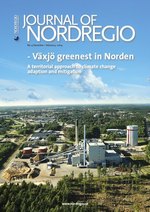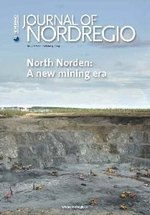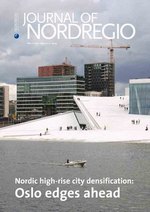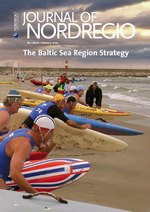Journal of Nordregio no 4, 2009
- Växjö greenest in Norden
A territorial approach to climate change adaption and mitigation
 Efforts to reduce CO2-emissions have a long history on the Nordic agenda. The Nordic countries in fact introduced taxes on such emissions back in the early 1990s. It was "out" with oil and "in" with rubbish and the leftovers from the forest-industry and even the agricultural sector. The emissions taxes put in place made such changes even more profitable. A practical example of this is the small Swedish city of Växjö, which has been acclaimed as the "greenest" city in Europe. See pp 6-9 in the lastest issue of the Journal of Nordregio.
Efforts to reduce CO2-emissions have a long history on the Nordic agenda. The Nordic countries in fact introduced taxes on such emissions back in the early 1990s. It was "out" with oil and "in" with rubbish and the leftovers from the forest-industry and even the agricultural sector. The emissions taxes put in place made such changes even more profitable. A practical example of this is the small Swedish city of Växjö, which has been acclaimed as the "greenest" city in Europe. See pp 6-9 in the lastest issue of the Journal of Nordregio.
Journal of Nordregio no 4, 2009
Journal of Nordregio no 3, 2009
Northern Norden: a new mining era
 Many parts of northern Norden are forging ahead into a new mining era. Future plans included doubling production of iron-ore in Kiruna, reopening the iron-mine at Kirkenes in Norway and also opening a completely new iron-mine close to Pajala in Northern Sweden. Both Sweden and Finland are also preparing new mining ventures in respect of gold, uranium and other minerals. Including Northwest-Russia, there are currently 42 functioning mines in the region. Within a few years there could be as many as 68. The basis for these developments is the enduring richness of the Fennoscandain Shield, which provides a geological structure ripe with assets.
Many parts of northern Norden are forging ahead into a new mining era. Future plans included doubling production of iron-ore in Kiruna, reopening the iron-mine at Kirkenes in Norway and also opening a completely new iron-mine close to Pajala in Northern Sweden. Both Sweden and Finland are also preparing new mining ventures in respect of gold, uranium and other minerals. Including Northwest-Russia, there are currently 42 functioning mines in the region. Within a few years there could be as many as 68. The basis for these developments is the enduring richness of the Fennoscandain Shield, which provides a geological structure ripe with assets.
Journal of Nordregio no 3, 2009
Journal of Nordregio no 2, 2009
Nordic high-rise city densification:
Oslo edges ahead
 High buildings in Nordic capital city centres – Helsinki is most restrictive Of the five Nordic capitals, Helsinki is most restrictive with regard to allowing high buildings in the city centre. In fact, the first and only high-rise building in the Finnish capital's city centre was completed in 1931. At the other of the scale is Oslo which is currently in the process of allowing a 350 metre long row of 10 high-rise buildings just behind the new Opera house. Oslo already has two huge buildings in the same area while in Stockholm there is significant pressure to again build 'high' in the city centre. The driving force behind the heavy densification policies in Oslo and Stockholm is first and foremost pressure from publicly-owned property development companies.
High buildings in Nordic capital city centres – Helsinki is most restrictive Of the five Nordic capitals, Helsinki is most restrictive with regard to allowing high buildings in the city centre. In fact, the first and only high-rise building in the Finnish capital's city centre was completed in 1931. At the other of the scale is Oslo which is currently in the process of allowing a 350 metre long row of 10 high-rise buildings just behind the new Opera house. Oslo already has two huge buildings in the same area while in Stockholm there is significant pressure to again build 'high' in the city centre. The driving force behind the heavy densification policies in Oslo and Stockholm is first and foremost pressure from publicly-owned property development companies.
Journal of Nordregio no 2, 2009
Journal of Nordregio no 1, 2009
The Baltic Sea Region Strategy
 A new Baltic Sea Region Strategy? According to EU figures 106 million people live in the Baltic Sea Region. They constitute some 23 % of the EU's population. The BSR's aggregated GDP is however only 16 % of EU's total GDP. On 14 December 2007 the EU's decision-making body (the European Council) launched an initiative to develop the Baltic Sea Region strategy. The primary purpose is to improve the environment and increase economic growth while making the area more attractive and accessible as well as safe and secure. The fact that some 2000 ships transits the Baltic Sea daily underlines the need for continuing coordinated security-measures. The plan is that the outlines for the new BSR-strategy shall be ready by June 2009.
A new Baltic Sea Region Strategy? According to EU figures 106 million people live in the Baltic Sea Region. They constitute some 23 % of the EU's population. The BSR's aggregated GDP is however only 16 % of EU's total GDP. On 14 December 2007 the EU's decision-making body (the European Council) launched an initiative to develop the Baltic Sea Region strategy. The primary purpose is to improve the environment and increase economic growth while making the area more attractive and accessible as well as safe and secure. The fact that some 2000 ships transits the Baltic Sea daily underlines the need for continuing coordinated security-measures. The plan is that the outlines for the new BSR-strategy shall be ready by June 2009.
Journal of Nordregio no 1, 2009